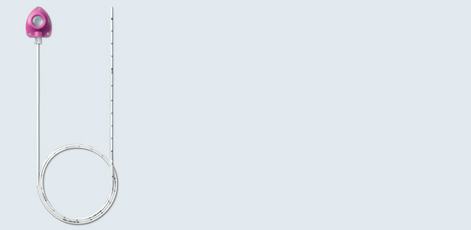primePICCport

The primePICCport is used to administer systemic chemotherapy, long-term parenteral nutrition or long-term medication. This port system also permits the high-pressure application of a contrast medium and it’s slim design allows for placement in the arm.
Benefits
Excellent plastic–titanium combination
The special combination of two materials provide light weight and high safety.
Nitinol Soft-Tip Guidewire
The Nitinol guidewire is anti-kinking and ensures a simple and smooth introduction of the device.
Suitable for high-pressure applications
The pressure resistance of the systems allows the application of certain substances with high pressure.
Safe identification
The radiopaque CT marking on the bottom of the port ensures safe identification as a high-pressure port.
Reduced risk of migration
The low weight reduces the risk of migration and increases patient comfort.
Slim design
The narrow shape of the port allows for its use for placement in the arm.
Easy placement
Small dimensions for easy placement.
MRT-conditional
Reduced artefact formation (up to 3.0T).
Connection mechanism
The transparent click-connector for the simple and easy connection as well as secure and reliable fixation of catheter and port chamber.
Advantages for patients
- Unlike other vascular access lines, with a pfmmedical primePICCport the patients hospital visits and planned nursing time is much less as there is no requirement for a weekly flush, dressing change, needle free or extension set change
- No additional protection needed when bathing or showering
- Patients lifestyle can continue as normal including travel and participating in most sports
- Compared to other vascular access Lines there is a lower risk of infection (1)
- Less vein punctures are required for long term therapy which preserves and improves vessel health
- Implantable ports from pfmmedical are used with an EZ Huber™ safety needle. Together they form a complete system giving patients and users a high level of safety
- Access with the Portacator® which provides improved port accessibility and patient safety
Technical Data
- Pressure stability: up to max. 21 bar/300 psi with maximum flow rate of 5 ml/s (3 ml/s with catheter 4.8 F)
- Length of catheter: 750 mm
- Dimension: 24.0 x 20.5 x 10.3 mm (L x W x H)
- Weight: 3.5 g
- Residual volume chamber: 0.30 ml
- Septum diameter: 8.0 mm
- Puncuture frequency (non-coring 19-G needle): 600
Catheter PU soft 1.0 x 1.6 mm
- Flow rate*: 14 ml/min.
- Residual volume: 0.10 ml/10 cm Length of catheter
*19-G-needle, 0.9-%-NaCl solution, Length of catheter 40 cm, Gravitation altitude difference 100cm
Practice
Vascular Access Device Selection
Selection of the correct vascular access device is vital to ensure that the patient is provided with a tailored device suited to the treatment that they need. How long is the patient’s treatment? What is the patient’s lifestyle like before and after treatment? How many times does the device need to be accessed?
- Right Line
- Right Time
- Right Place
- Right Patient
- Right Training
Training and Education
pfmmedical have an ongoing commitment to offering extensive and in-depth training and education, which plays a vital role for Patients, Practitioners and Clinicians.
Read more
Knowledge
The required flow rate and pressure stability (for the injection of contrast media for CT examinations) can be ensured by using a EZ Huber™ safety infusion cannula (to avoid needlestick injuries). Both product ranges are available from pfm medical.
Test conditions: High-pressure injector with a set maximum pressure of 21 bar/300 psi; flow rate 5 ml/s; connection tube 1.5 m, 60 s; contrast medium Visipaque® 320 at a temperature of 37 to 38°C; with vascular simulation; Jetcan™ (19 G, 25 mm) Huber needle with extension. Instructions for use and port care advice must be strictly adhered to. Data from in-vitro test series are available on request.
Handling
The pfmmedical CT rated, power-injectable, primePICCport is placed using a similar procedure as a PICC, ultrasound-guided puncture with Modified Seldinger Technique and possible verification of positioning with the ECG Tip Technology.
Configurations
- 1 Port with CT marking
- 1 Catheter with atraumatic tip
- 2 Click-connectors
- 1 Rinsing needle
- 1 JetCan™ straight Huber needle (22 G, 25 mm)
- 1 Vein lifter
- 1 purple bracelet for identification of high-pressure port
- 1 Introducer kit (peel-away sheath with dilator, guide wire 700 mm with J-tip, puncture needle)
- 1 Tunnelling needle
- 1 Patient ID-card
Manufacturer
pfm medical cpp SA
9, Allée du Quartz
CH 2300 La Chaux-de-Fonds, Switzerland
Ordering Information
| REF | Description | OD | ID | Catheter | PU |
|---|---|---|---|---|---|
| 61.636.09.077-ARM | primePICCport | 1.6mm | 1.0mm | 4.8F | 1 |
Downloads
Literature
1. Coady, K. et al (2015) A comparison of infections and complications in central venous catheters in adults with solid tumours. Journal of Vascular Access. 16(1):38-41.